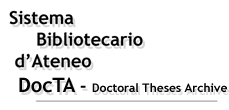|
|
DocTA - Doctoral Theses Archive >
Tesi di dottorato >
SCUOLA DI DOTTORATO IN ECONOMIA E FINANZA DELL'AMMINISTRAZIONE PUBBLICA >
Citazione:
Utilizza queste indicazioni per citare o creare un link a questo documento.
|
Fiocco, Raffaele. "The Regulatory Policy as the Outcome of a Bargaining Process", Università Cattolica del Sacro Cuore, XXI ciclo, a.a. 2007/08, Milano, [http://hdl.handle.net/10280/644].
|
| Titolo: | The Regulatory Policy as the Outcome of a Bargaining Process |
| Autore/i: | FIOCCO, RAFFAELE |
| Tutor: | GILLI, MARIO ROBERTO |
| Coordinatore: | BORDIGNON, MASSIMO |
| Lingua: | ENG |
| Abstract in italiano della tesi: | Lo scopo della nostra ricerca è di proporre un modello dell'intervento pubblico che differisce dall'approccio standard e di valutare le sue implicazioni in termini di benessere. Noi sosteniamo che in molte circostanze la regolamentazione risulta essere un processo di "give-and-take" pittosto che di "take-it-or-leave-it". Più precisamente, la nostra idea è che la politica regolamentatoria possa essere più generalmente modellizzata come il risultato di un processo di contrattazione, che normalmente implica la partecipazione attiva di ciascun agente coinvolto nell'interazione regolamentatoria. Nel Capitolo 1, seguendo l'intuizione di Spulberg, la regolamentazione è modellizzata come un processo di negoziazione tra i gruppi di interesse dei consumatori e delle imprese, con l'agenzia nel ruolo di mediatore. La nostra analisi mostra che l'impresa regolamentata sfrutta il suo potere contrattuale per ottenere un sussidio, il quale è più elevato che con un'offerta "take-it-or-leave-it" di un meccanismo che massimizza il benessere sociale. L'eccessiva sussidiazione dell'impresa penalizza i consumatori ed implica una perdita di benessere sociale. Noi troviamo altresì che, con informazione asimmetrica sui costi, l'intervallo di tipi dell'impresa che partecipano in equilibrio all'interazione regolamentatoria può essere più grande con la politica negoziata che con la politica "take-it-or-leave-it". Vorremmo sottolineare che il Capitolo 1 è introduttivo e costituisce un passo preliminare per la nostra ricerca. Aldilà dei risultati analitici, il suo contributo è duplice. Innanzitutto, esso descrive le strutture basilari di una politica regolamentatoria negoziata e le sua implicazioni in termini di benessere. In secondo luogo, esso mostra che l'approccio basato sulla contrattazione rappresenta effettivamente un'estensione piuttosto che una negazione dell'approccio standard. In particolare, la contrattazione su una politica regolamentatoria può essere interpretata come un modello generale che include l'offerta "take-it-or-leave-it" come caso limite, che si verifica quando l'impresa è privata di qualsiasi potere di contrattazione durante le negoziazioni. La discussione nel Capitolo 2 sviluppa la struttura precedente e considera un'agenzia che è delegata dal Congresso a rappresentare gli interessi dei consumatori nel precesso di contrattazione con l'impresa sulla politica regolamentatoria. L'esistenza di un'attività di negoaziazione tra l'agenzia e l'impresa è stata largamente ignorata dalla letteratura economica, con la principale eccezione rappresentata dai contributi di Scarpa. Comunque, Armstrong e Sappington, nella loro rassegna sui recenti sviluppi nella teoria della regolamentazione, hanno riconosciuto che la formulazione standard, la quale alloca tutto il potere di contrattazione al regolamentatore, è adottata per convenienza tecnica piuttosto che per realismo. Mentre l'agenzia è stata precedentemente raffigurata come un arbitro imparziale, nel Capitolo 2 supponiamo che essa rappresenti una parte contrattuale, la cui natura può essere benevolente od egoista. In questo contesto, noi studiamo la possibilità di collusione tra l'agenzia regolamentatoria e l'impresa regolamentata, un fenomeno che spesso si verifica in una relazione regolamentatoria. La contrattazione "a latere" tra i due partner colludenti è modellizzata come un processo di negoziazione (eventualmente illegale)parallelo alla negoziazione sulla politica regolamentatoria. La nostra analisi mostra che i consumatori sono penalizzati dalla corruzione, in quanto essi interamente sussidiano il guadagno totale dalla collusione. Inoltre, il nostro modello suggerisce che un'agenzia più forte nel processo di contrattazione rende più desiderabile per il Congresso (cioè per i consumatori)consentire la collusione in equilibrio. Nei primi due capitoli, noi abbiamo considerato l'esistenza di solamente un mercato monopolistico. Il Capitolo 3, che ha beneficiato del contributo fondamentale di Carlo Scarpa, estende l'impianto precedente ed esamina la regolamentazione di due mercati interdipendenti quando i beni sono sostituti. Questo è il caso, per esempio, nelle industrie del gas naturale e dell'elettricità o delle ferrovie e autostrade. Noi ci focalizziamo sul progetto della struttura regolamentatoria. In particolare, noi intendiamo determinare se è meglio per il benessere dei consumatori avere un'autorità unica per entrambi i mercati o suddividere la giurisdizione regolamentatoria tra due differenti agenzie. Quando la politica regolamentatoria è il risultato di un'offerta "take-it-or-leave-it", la nostra analisi mostra che due agenzie - ciascuna massimizzante il surplus totale nel suo proprio mercato - impongono prezzi che sono più bassi di quelli derivanti da centralizzazione regolamentatoria. Al contrario, quando la politica regolamentatoria è il risultato di un processo di contrattazione, noi troviamo che un regolamentatore unico, che sequenzialmente contratta con entrambe le imprese, dà ai consumatori un livello di benesere più elevato, purchè il costo ombra dei fondi pubblici, attraverso i quali la produzione è sussidiata, sia sotto una certa soglia. Dunque, in presenza di negoziazioni, il nostro modello suggerisce che la centralizzazione dovrebbe essere la migliore struttura regolamentatoria per i consumatori nei paesi sviluppati, ove la raccolta fiscale non è troppo distorsiva. Se il costo ombra è sopra questa soglia, come spesso accade nei paesi in via di sviluppo, decentralizzare la struttura regolamentatoria risulta in un miglioramento del benessere sociale. |
| Abstract in inglese: | The aim of our research is to propose a pattern of government intervention which
differs from the standard approach and to assess its welfare implications. We argue that
in many circumstances regulation turns out to be a process of give-and-take rather than
take-it-or-leave-it. More precisely, our idea is that the regulatory policy can be more generally
modelled as the outcome of a bargaining process, which normally entails the active
participation of each agent involved in the regulatory interaction.
In Chapter 1, following Spulber’s intuition,
regulation is modelled as a negotiation process between the consumers’ and firm’s interest
groups, with the agency in the role of mediator. Our analysis shows that the regulated
firm exploits its bargaining power to obtain a subsidy which is higher than under a take-it-
or-leave-it offer of a total surplus maximizing mechanism. The oversubsidization of
the firm penalizes consumers and entails a total surplus loss. We find also that, under
asymmetric cost information, the range of the firm’s types participating in equilibrium in
the regulatory interaction may be wider under the negotiated policy than under the take-it-or-
leave-it policy.
We would like to stress that Chapter 1 is introductory and constitutes a preliminary
step for our research. On top of the specific analytical results, its contribution is twofold.
First, it describes the basic features of a negotiated regulatory policy and its welfare implications.
Second, it shows that the bargaining approach to regulation actually represents an
extention rather than a negation of the standard approach. In particular, the bargaining over
a regulatory policy may be interpreted as a general set-up which includes the take-it-or-leave-
it offer as a limit case, that occurs when the firm is deprived of any bargaining power
during negotiations.
The discussion in Chapter 2 develops the previous framework and considers an agency
which is delegated by Congress to represent consumers’ interests in the bargaining process
with the firm over a regulatory policy.
The existence of a negotiation activity between the agency and the firm has been
by and large ignored by the economic literature, with the main exception represented by Scarpa’s contributions. However, Armstrong and Sappington, in their review
on the recent developments in the theory of regulation, have recognized that the standard
formulation, which allocates all the bargaining power to the regulator, has been adopted for
technical convenience rather than for realism.
While it has been previously depicted as an impartial arbitrator, the agency is assumed
in Chapter 2 to represent a bargaining party, whose nature may be either benevolent
or self-interested. In this setting, we study the potential for collusion between the regulatory
agency and the regulated firm, a phenomenon which often occurs in a regulatory
relationship. The side contracting between the two colluding partners is modelled as a
(possibly illegal) negotiation process parallel to the bargaining over the regulatory policy.
Our analysis shows that consumers are penalized by corruption, since they entirely subsidize
the total stake in collusion. Furthermore, our model suggests that a stronger agency in
the bargaining process makes it more desirable for Congress (i.e. for consumers) to allow
collusion in equilibrium.
In the first two chapters, we have considered the existence of just one monopolistic
market. Chapter 3, which has benefited from the fundamental contribution of Carlo Scarpa,
extends the previous setting and examines the regulation of two interdependent markets,
whose goods are substitutes. This is the case, for instance, in the industries of natural
gas and electricity or railroads and motorways. We focus on the design of the regulatory
structure. In particular, we intend to determine whether it is better for consumers’ welfare
to have a unique authority for both markets or to split the regulatory jurisdiction between
two different agencies. When the regulatory policy is the outcome of a take-it-or-leave-it offer, our analysis
shows that two agencies - each maximizing total surplus in its own market - set prices
which are lower than those arising under regulatory centralization.
On the contrary, when the regulatory policy is the outcome of a bargaining process,
we find that a unique regulator, which sequentially bargains with both firms, gives consumers
a higher welfare level, as long as the shadow cost of public funds, through which
production is subsidized, is below a certain threshold. Hence, under negotiations our model
suggests that centralization should be the best regulatory pattern for consumers in developed
countries, where tax collection is not too distortionary. If the shadow cost is above
that threshold, as it often happens in developing countries, decentralizing bargaining turns
out to be consumers’ welfare improving. |
| Data di discussione: | 18-feb-2009 |
| URI: | http://hdl.handle.net/10280/644 |
| È visualizzato nelle collezioni: | SCUOLA DI DOTTORATO IN ECONOMIA E FINANZA DELL'AMMINISTRAZIONE PUBBLICA
FACOLTA' DI ECONOMIA
|
File in questo documento:
| File |
Dimensioni | Formato | Accessibilità |
|---|
| Testo_completo_FIOCCO.pdf | 17,14 MB | Adobe PDF | non consultabile
|
|
Accesso e utilizzo dei contenuti di DocTA
|



